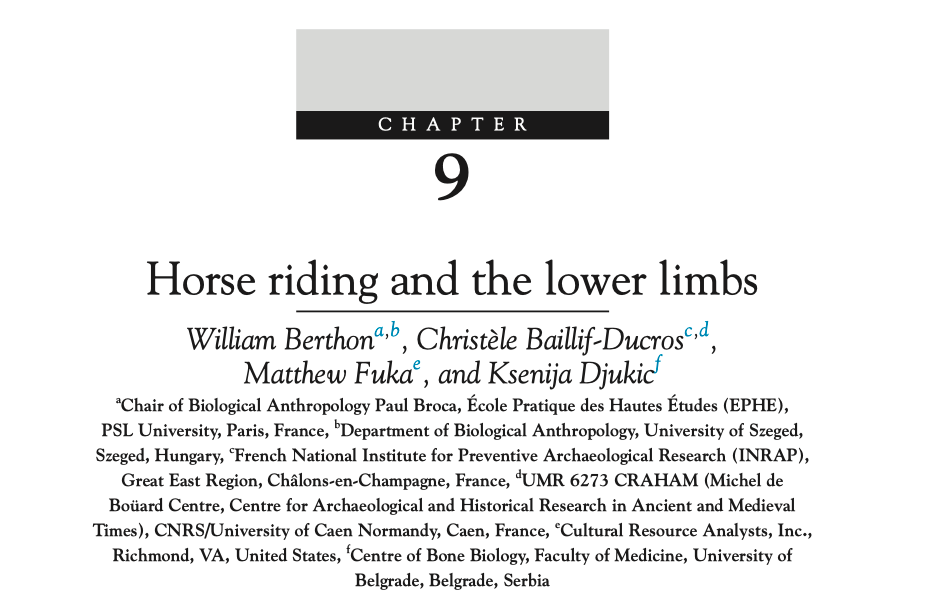News
What is new in bioanthropology?
In February, the book BEHAVIOUR IN OUR BONES – How Human Behaviour Influences Skeletal Morphology was published. The book is edited by Cara Stella Hirst (Institute of Archaeology, University College London, United Kingdom), Rebecca J. Gilmour (Department of Sociology & Anthropology, Mount Royal University, Calgary, AB, Canada), Kimberly A. Plomp (School of Archaeology, University of the Philippines, Diliman, Quezon City, Manila, Philippines) and Francisca Alves Cardoso (LABOH—Laboratory of Biological Anthropology and Human Osteology, CRIA—Center for Research in Anthropology, NOVA University of Lisbon—School of Social Sciences and Humanities (NOVA FCSH), Lisbon, Portugal. Cranfield Forensic Institute, Cranfield University, Defence Academy of the United Kingdom, Shrivenham, United Kingdom) and published by Elsevier. Our contribution to this book can be seen in Chapter 9, where we share our knowledge and experience in the field of micro and macro analyses of entheses.
A word from the editors: Chapter 9, ‘Horse riding and the lower limbs’ by William Berthon, Christèle Baillif-Ducros, Matthew Fuka, and Ksenija Djukic, takes a more focused and detailed look at how horseback riding, a critical activity in human history, can leave evidence on the skeletal lower limbs. Horseback riding had a boundless impact on ancient societies, affecting our subsistence strategies, dispersal, and warfare. This chapter weaves together biological anthropology with archaeology, human anatomy, and sports medicine to understand how horse riding affects the skeleton and how we can identify those indicators to infer the practice of horse riding in the past. Importantly, they also provide a critical assessment of some methodological approaches to this subject and suggest future research trajectories to help us more reliably identify skeletal changes related to horse riding (Kimberly A. Plomp, Rebecca J. Gilmour, and Francisca Alves Cardoso. 2023. Skeletons in action: Inferring behaviour from our bones in (eds. Cara Stella Hirst, Kimberly A. Plomp, Rebecca J. Gilmour, and Francisca Alves Cardoso) BEHAVIOUR IN OUR BONES – How Human Behaviour Influences Skeletal Morphology. Elsevier: 5.).

What is new in the liver and bone interaction research?
In the last year, staff of the Center of Bone Biology conducted various multi-scale assessments of bone quality alterations of lumbar vertebrae obtained from individuals with congestive hepatopathy and nonalcoholic fatty liver disease. These findings indicate that these liver diseases have a negative effect on bone strength. Thus, clinical assessment of fracture risk should be advised for patients with congestive hepatopathy and nonalcoholic fatty liver disease. These results were published in Histochemistry and Cell Biology and Journal of Endocrinological Investigation.

Our recent article published in the Journal of Anatomy revealed decreased osteocytic Cx43 expression, suggesting compromised osteocytic intercellular communication in individuals with alcoholic liver cirrhosis (ALC). Considering that our study revealed significant associations between the level of liver tissue disturbances and impaired functionality of the osteocyte lacunar network, we may assume that liver disease treatment may affect the progression of ALC-induced bone alterations. Last, increased sclerostin expression in bone samples from individuals with ALC illuminated that decreased bone formation could be an important mechanism in the pathogenesis of ALC-induced bone fragility. With that in mind, we may speculate that treatment targeting low bone formation could have beneficial effects in attenuating bone changes among ALC patients.

Study Uncovers Link Between Type 2 Diabetes, Vascular Complications, and Impaired Bone Microarchitecture
A recent study delved into the connection between type 2 diabetes mellitus (T2DM) and hip fractures, with a specific focus on the role of vascular complications. The impact of T2DM on bone fragility and the underlying microstructural factors have been subjects of ongoing debate. To shed light on this issue, we conducted an investigation involving 32 individuals, including 18 T2DM patients with hip fractures and 14 healthy controls of similar age and gender distribution. Using advanced imaging techniques, three-dimensional micro-computed tomography (micro-CT), we analyzed the microarchitecture of the femoral neck’s trabecular bone. The group with T2DM was further categorized based on the presence or absence of vascular complications. These findings demonstrate the existence of two distinct bone fragility profiles among individuals with T2DM. Patients with vascular complications exhibit compromised trabecular microarchitecture of the femoral neck. By unraveling the complex relationship between T2DM, vascular complications, and bone health, in the future, researchers could develop targeted interventions that can mitigate fracture risks in individuals with T2DM, particularly those with accompanying vascular complications.

